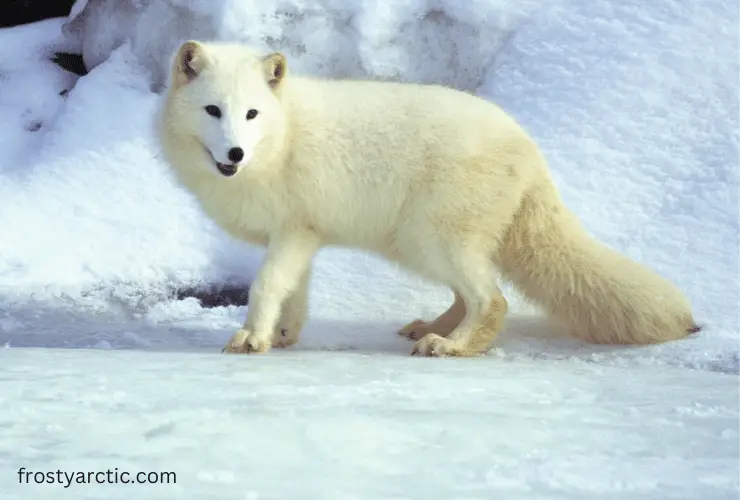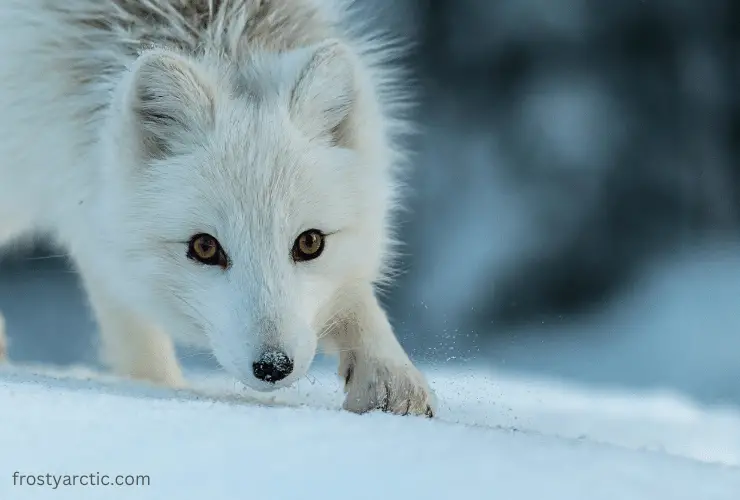No, the arctic foxes do not hibernate or migrate. The physical adaptations of this arctic animal help it survive the harsh climate, so the arctic foxes never have to hibernate or migrate.
Hibernation is a means of energy conservation. In the case of arctic foxes, they have different behaviors and physical features that help them survive without even hibernating.
Arctic foxes are omnivores and can change their diet during severe months to stay alive. Moreover, they have a communal and nomadic behavior, establishing small groups to search for food. They also make dens in a rock mound at the base of a cliff.
How Do Arctic Foxes Adapt to Their Environment?
Following are the adaptations they make to be a fighter for the environment they own or live in:
a) Food Adaptation
An arctic fox has super tactics to save itself from food scarcity during harsh winters. You can call it an opportunist in terms of food needs. It is done in many ways:
- It caches the food by placing some objects underground during summer and fall.
- It has a strong system inside its body to store fat and use it as an energy source in winter.
- It lowers its mobile activity and basal metabolic rate to save energy during winters, hence requiring less food to gain energy.
b) Physical Adaptation
The arctic fox’s body is designed to survive freezing temperatures. More than one part of its body joins in to serve the purpose.
1. Fur of the arctic fox, which has insulative properties. The oil in the fur keeps the moisture away.
2. The short muzzle, nose and legs become a source of conserving heat.
3. The short, rounded body can even curl up, reducing the surface area to avoid exposure to cold on a large scale. The best-insulated parts of the body expose more to bear the cold well.
4. A net of arteries and veins under the skin of pads prevents freezing of the body when the arctic fox stands on a cold rock.
Do Arctic Foxes Hibernate or Migrate?
Arctic foxes do not generally migrate, as you may say that 95% of the community does not. Only 5% of these arctic animal does.

They migrate using the frozen sea ice as loathing boards. It is an observation that in 2017, a blue arctic fox was seen migrating.
Blue arctic fox —Migration evidence
- Traveled 35000 Km
- From Norway to Canada
- In 76 days
It would be good to describe their migration as a tour with family groups in small commuting groups for a certain time period. It has been observed that they travel long distances of several hundred kilometers.
In Alaska, the group moves seaward in fall and early winter and returns in late winter and early spring.
The reason for the arctic foxes to migrate is to overcome the scarcity of food in their territory. So far, the hibernation is concerned; it is not for the arctic foxes.
Migration Of Arctic Foxes: Some Uncanny Facts
Foxes migrate, and there are evidence and reasons for their migration you might find spread on the web:
1) In 2010, an arctic fox was seen traveling for four months, making a record in movement and speed rate.
The fox’s journey began on the island of Spitsbergen, off the coast of Norway in the Svalbard archipelago, and ended on Ellesmere Island in Canada’s remote Nunavut Territory, a full continent away. Thus, it was a cross-continental migration.
2) The arctic foxes are nick-named as northern nomads or ice travelers due to the observations of their short communal trips to the sea ice from the tundra. They return to the tundra after the severe weather to breed and feed their young ones.
3) It is the sea ice actually which takes the lead. As told by researcher Eva Fugeli, the mountain foxes move between areas to meet other populations and to get food and sea ice bridges the gap for them.
How Long Do Arctic Foxes Hibernate?
Arctic foxes remain active all year round and don’t need to hibernate. Why is it so? It is because hibernation is required when animals face food shortages in extreme winters.
However, they sleep for up to two weeks when they face a severe cold or no food. They dig a den in the snow and turn into a snowball, sleeping for 2 weeks.

Note: Arctic foxes are opportunistic omnivores who change their diet in severe weather, switching to fruits and nuts, which they cache during summer.
Can An Arctic Fox Survive in The Heat?
No, the arctic foxes are susceptible to high temperatures and their body can overheat easily if they are in warm regions.
Although, the body mechanism of the arctic fox still helps it stay cool during summer. It keeps its brain cool by taking in air through the nose.
Can Arctic Foxes Freeze to Death?
No, the arctic foxes do not freeze to death. The fat layer under the arctic fox’s skin helps it survive the deadly cold.
We assume -58 degree centigrade is the survival line for the arctic fox. But it even goes beyond that. It rolls itself into a ball, puts its chin on its paws and covers its nose with its tail.
A furry, white ball minimizing the exposed body area, the arctic fox goes to the limit of -70 degree centigrade.
FAQs
What do arctic foxes do in the winter?
The arctic foxes remain active in winter and eat cached food. They even migrate to the coastal areas in the early winter, moving in large family groups. When the food scarcity increases, they follow the polar bear to eat its leftover kills.
Can an Arctic fox survive in the heat?
It can survive mild summers and has a system of cooling itself by inhaling cool air through the nose.
How long do arctic foxes sleep?
It does not sleep for a long period of time like hibernated animals. But if the weather goes bad and the food shortage increases, the fox curls itself into a ball and sleeps in a self-dug snow den for up to 2 weeks.
Conclusion
Arctic foxes are amazing creatures. They have an incredible capability to stay warm in freezing cold. Hibernation or migration is a tactic they play for survival.
Rather than the cold, global warming is now threatening their survival. However, as the world’s climate and people’s behaviors are ever-changing, you can expect static facts all the time.
Dr. Erik D. Doerr from Australian National University interestingly states that people’s assumptions about animal movements can be an old tale if they do close tracking (Source).



3 thoughts on “Do Arctic Foxes Hibernate or Migrate?”